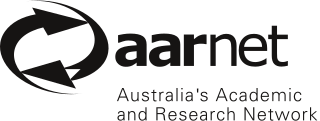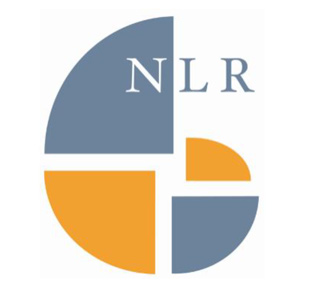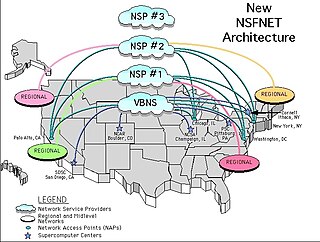
Janet is a high-speed network for the UK research and education community provided by Jisc, a not-for-profit company set up to provide computing support for education. It serves 18 million users and is the busiest National Research and Education Network in Europe by volume of data carried. Previously, Janet was a private, UK-government funded organisation, which provided the JANET computer network and related collaborative services to UK research and education.

A metropolitan area network (MAN) is a computer network that interconnects users with computer resources in a geographic region of the size of a metropolitan area. The term MAN is applied to the interconnection of local area networks (LANs) in a city into a single larger network which may then also offer efficient connection to a wide area network. The term is also used to describe the interconnection of several LANs in a metropolitan area through the use of point-to-point connections between them.
In telecommunications, packet switching is a method of grouping data into short messages in fixed format, i.e. packets, that are transmitted over a digital network. Packets are made of a header and a payload. Data in the header is used by networking hardware to direct the packet to its destination, where the payload is extracted and used by an operating system, application software, or higher layer protocols. Packet switching is the primary basis for data communications in computer networks worldwide.
The National Science Foundation Network (NSFNET) was a program of coordinated, evolving projects sponsored by the National Science Foundation (NSF) from 1985 to 1995 to promote advanced research and education networking in the United States. The program created several nationwide backbone computer networks in support of these initiatives. It was created to link researchers to the NSF-funded supercomputing centers. Later, with additional public funding and also with private industry partnerships, the network developed into a major part of the Internet backbone.

Internet2 is a not-for-profit United States computer networking consortium led by members from the research and education communities, industry, and government. The Internet2 consortium administrative headquarters are located in Ann Arbor, Michigan, with offices in Washington, D.C., and Emeryville, California.
A leased line is a private telecommunications circuit between two or more locations provided according to a commercial contract. It is sometimes also known as a private circuit, and as a data line in the UK. Typically, leased lines are used by businesses to connect geographically distant offices.

Abilene Network was a high-performance backbone network created by the Internet2 community in the late 1990s. In 2007 the Abilene Network was retired and the upgraded network became known as the "Internet2 Network".

AARNet provides Internet services to the Australian education and research communities and their research partners.

National LambdaRail (NLR) was a 12,000-mile (19,000 km), high-speed national computer network owned and operated by the U.S. research and education community. In November 2011, the control of NLR was purchased from its university membership by a billionaire Patrick Soon-Shiong. NLR ceased operations in March 2014.
Optical Carrier transmission rates are a standardized set of specifications of transmission bandwidth for digital signals that can be carried on Synchronous Optical Networking (SONET) fiber optic networks. Transmission rates are defined by rate of the bitstream of the digital signal and are designated by hyphenation of the acronym OC and an integer value of the multiple of the basic unit of rate, e.g., OC-48. The base unit is 51.84 Mbit/s. Thus, the speed of optical-carrier-classified lines labeled as OC-n is n × 51.84 Mbit/s.

TeraGrid was an e-Science grid computing infrastructure combining resources at eleven partner sites. The project started in 2001 and operated from 2004 through 2011.
The Corporation for Education Network Initiatives in California is a nonprofit corporation formed in 1997 to provide high-performance, high-bandwidth networking services to California universities and research institutions. Through this corporation, representatives from all of California's K-20 public education combine their networking resources toward the operation, deployment, and maintenance of the California Research and Education Network, or CalREN. Today, CalREN operates over 8,000 miles of fiber optic cable and serves more than 20 million users.

The very high-speed Backbone Network Service (vBNS) came on line in April 1995 as part of a National Science Foundation (NSF) sponsored project to provide high-speed interconnection between NSF-sponsored supercomputing centers and select access points in the United States. The network was engineered and operated by MCI Telecommunications under a cooperative agreement with the NSF.

Michael Alexander McRobbie is an Australian–American computer scientist and university administrator. He served as the 18th president of Indiana University from 2007 to 2021. Upon stepping down from the IU presidency, McRobbie was replaced by Pamela Whitten, who became the 19th president of Indiana University on July 1, 2021. On July 1, 2021, he assumed the titles of university chancellor, president emeritus and university professor. He is the third person to serve as university chancellor in the university's more than 200-year-old history.
Internet access is widely available in New Zealand, with 94% of New Zealanders having access to the internet as of January 2021. It first became accessible to university students in the country in 1989. As of June 2018, there are 1,867,000 broadband connections, of which 1,524,000 are residential and 361,000 are business or government.
In Romania, there are 18.8 million connections to the Internet. Romania's country code is .ro. The .eu domain is also used, as it is shared with other European Union member states. There were over 600 000 domains registered under .ro at the end of 2012.

Stephen South Wolff is one of the many fathers of the Internet. He is mainly credited with turning the Internet from a government project into something that proved to have scholarly and commercial interest for the rest of the world. Dr. Wolff realized before most the potential in the Internet and began selling the idea that the Internet could have a profound effect on both the commercial and academic world.

Merit Network, Inc., is a nonprofit member-governed organization providing high-performance computer networking and related services to educational, government, health care, and nonprofit organizations, primarily in Michigan. Created in 1966, Merit operates the longest running regional computer network in the United States.
The Israel InterUniversity Computation Center (IUCC), implements, operates and maintains the national research and education network (NREN) of Israel.
AMPATH was developed in 2000 as a high performance exchange point in Miami, Florida, United States. AMPATH assists peer based and network research between U.S. and international research and education networks.











